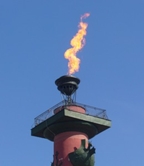 Victory square, Saint-PetersburgIt is located in the very end of Moskovsky Prospekt near Pulkovo Airport – not in the central part of the city, despite this name being common in the former Soviet cities as a central city square. The nearest metro station is Moskovskaya. On May 9, 1975, on the thirtieth anniversary of the victory of the Soviet people over Nazi Germany, the monument was unveiled. The centre of square is graced by a magnificent monument devoted to the heroes of the defence of Leningrad during the Second World War (by Lenin Prize winners Mikhail Anikushin, Sergei Speransky, and Valentin Kamensky). The monument faces the south, where the fiercest battles for Leningrad were fought. The centre of the composition consists of a 48-metrehigh granite obelisk with the Inscription 1941-1945 in gold. The foot of the monument is embellished with seven meter high sculptural group called "The Victors" (a Worker and a Soldier), symbolizing the inseparable ties between the army and the people. On either side of the main staircase, groups of bronze sculptures stand on granite pedestals. On the left side are "Sailors", "The People's Avengers" (Partisans), and "The Builders of the Defences"; on the right side are "Soldiers", "Founders", and "People's Volunteers". These four-meter high sculptural compositions show you the heroes of the besieged Leningrad.
The granite steps descend to the memorial hall housed under the monument where the feats of the city's defenders are recorded in bronze and mosaics, and are reflected in mementoes of the war. The tragic and noble melodies of the song Holy War and Shostakovich's Seventh Symphony alternate with the rhythmic beating of the metronome which ticks away on the radio as it did when the besieged city was struggling to stay alive. But life went on in the city, as can be seen from the calendar of each of the 900 days of the blockade. The chronicle of Leningrad's feat is recorded on the pages of the Bronze Memorial Book erected on a granite pedestal in the centre of the memorial. |
 Сайт сделан под разрешение экрана 1280 на 800. Если страницы отображаются некорректно, настройте разрешение экрана: Рабочий стол-правая кнопка мыши-свойства-параметры-разрешение экрана. |
|
|
|
|







